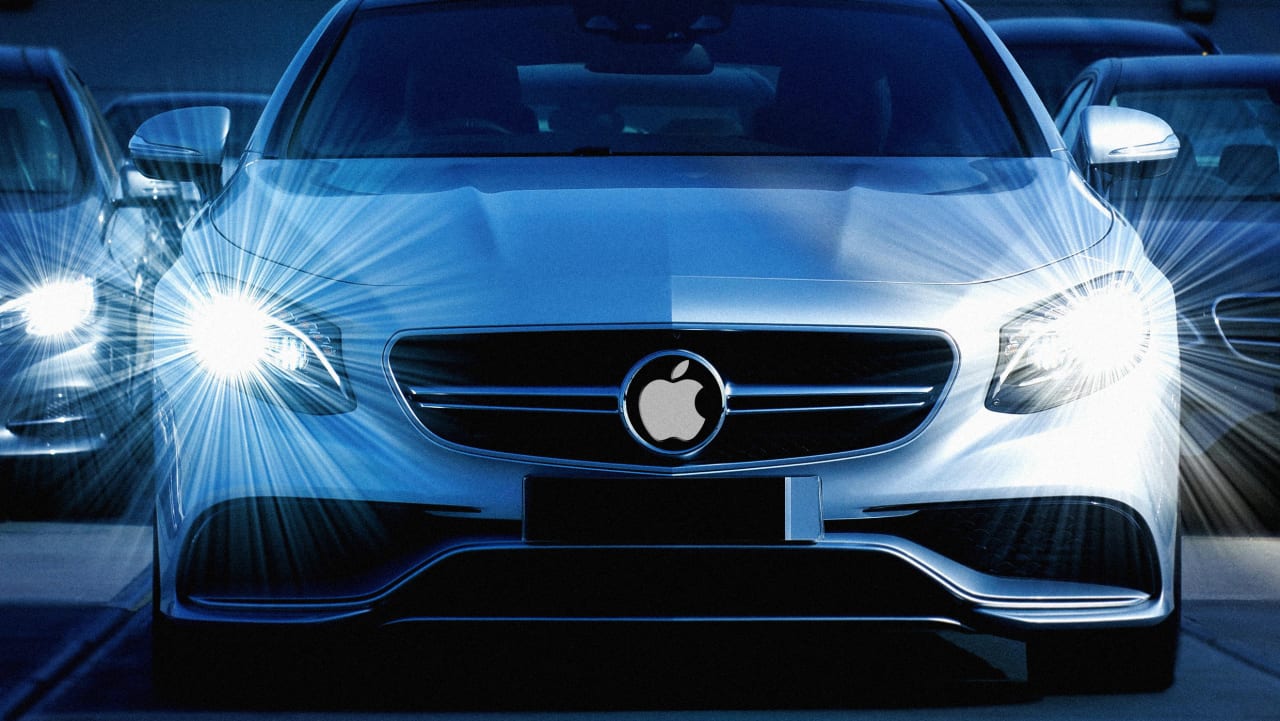Apple’s pursuit of perfection has led to product paralysis
Earlier this week, Apple officially called off its decade-long attempt to build an automobile. The project, reportedly codenamed “Titan,” went through multiple leadership and strategy changes according to the New York Times and Bloomberg, but now Apple’s cutting its losses and having its employees focus on generative AI instead. An Apple car was always going to be a long shot, but its demise is really just a more grandiose version of Apple’s recent inability to ship hardware beyond its core products. Over the past few years, we’ve heard all sorts of rumors about smart displays, TV devices, foldable phones, and more, yet nothing’s materialized as Apple reportedly dithers over the details. Some of those products should be low-hanging fruit for Apple and would fulfill clear needs for customers, especially compared to electric vehicles or self-driving systems. Even so, Apple seems lost how to get them out the door. The smart display that wasn’t Apple’s reportedly been working on a smart display since at least 2021, when Bloomberg’s Mark Gurman described early development on “a high-end speaker with a touch screen” along with a camera for video chat. This was not a wild new concept at the time. Amazon and Google had already been shipping smart displays for the past few years, and it turns out they make excellent digital photo frames. I’ve had a Lenovo Smart Display in the kitchen since 2018, and seeing it cycle through Google Photos albums is both an endless source of delight and a major factor keeping my family tethered to Google’s ecosystem, paying for increasing amounts of cloud storage. So why can’t Apple ship something similar for iCloud Photos users? Subsequent reports claim that Apple has explored different mounting solutions and screen sizes, but seems no closer to releasing anything despite the launch of StandBy—essentially a smart display mode for newer iPhones—last fall. Gurman now says not to expect a smart display until 2025 at the earliest. Fiddling with foldables Apple’s pursuit of perfection has also kept it from shipping a foldable phone to compete with the likes of Samsung. Rumors of an Apple foldable date back to 2016, and Gurman reported in early 2021 that Apple had started early testing on foldable displays for iPhones. Three years later, The Information reported that Apple is still in early development. The company reportedly wants the device to be no thicker than a regular iPhone when it’s folded shut and may not ship anything if it can’t meet that goal. On the Android side, foldable phones are already here, and they’re awesome. A little extra bulk is a worthy trade-off for being able to fit a tablet in your pocket or stow a half-sized phone in a your handbag, and besides, the difference in thickness is quickly becoming negligible: Honor’s Magic V2 measures just 9.9mm when folded, just 20% thicker than an iPhone 15 Pro Max. These phones are pricey—Samsung’s Fold5 starts at $1,800—but keep in mind the iPhone Pro Max is the bestselling smartphone worldwide according to Canalys, because people want the biggest and best iPhone and are willing to pay a premium for it. Apple could charge a hefty sum for an even bigger foldable phone that people would love, yet it won’t accept anything short of a perfection that may never come. Endless TV hardware toiling Meanwhile, Apple has lost the plot on the TV front, as it experiments with all kinds of weird hardware instead of doing the obvious and shipping a smart TV. The Apple TV 4K is a great streaming box, but it exists in a world where more people are content to just use whatever software is built into their televisions. According to Conviva, viewing time on smart TVs overtook external streaming boxes in 2022 and continues to grow at a faster rate. People spend hours of daily leisure time on TVs, yet Apple’s ceding full control over that experience to the likes of Google, Amazon, Roku, and Samsung. Sure, you can download the Apple TV app on those other platforms, but they have little incentive to promote Apple’s content and create ties to other Apple services such as Music and HomeKit. Not being in control also limits Apple’s ability to expand its targeted ad business into the TV realm. What’s Apple doing instead? Experimenting with dead-end ideas like a soundbar that doubles as a streaming box. Roku, Amazon, and Google have been putting out this exact type of product for years, but it’s a hard concept to understand and there’s no evidence that people are buying them on a large scale. Perhaps it’s just as well that Apple hasn’t managed to ship one of these devices either, even after years of rumored development. Failures to launch Smart displays, foldables, and TVs aren’t the only areas where Apple’s seemed stuck. The company’s vacillated on smart speakers, having discontinued the original HomePod in 2021 to focus on the cheaper HomePod Mini, only to bring back a barely improved version last year.

Earlier this week, Apple officially called off its decade-long attempt to build an automobile. The project, reportedly codenamed “Titan,” went through multiple leadership and strategy changes according to the New York Times and Bloomberg, but now Apple’s cutting its losses and having its employees focus on generative AI instead.
An Apple car was always going to be a long shot, but its demise is really just a more grandiose version of Apple’s recent inability to ship hardware beyond its core products. Over the past few years, we’ve heard all sorts of rumors about smart displays, TV devices, foldable phones, and more, yet nothing’s materialized as Apple reportedly dithers over the details.
Some of those products should be low-hanging fruit for Apple and would fulfill clear needs for customers, especially compared to electric vehicles or self-driving systems. Even so, Apple seems lost how to get them out the door.
The smart display that wasn’t
Apple’s reportedly been working on a smart display since at least 2021, when Bloomberg’s Mark Gurman described early development on “a high-end speaker with a touch screen” along with a camera for video chat.
This was not a wild new concept at the time. Amazon and Google had already been shipping smart displays for the past few years, and it turns out they make excellent digital photo frames. I’ve had a Lenovo Smart Display in the kitchen since 2018, and seeing it cycle through Google Photos albums is both an endless source of delight and a major factor keeping my family tethered to Google’s ecosystem, paying for increasing amounts of cloud storage.
So why can’t Apple ship something similar for iCloud Photos users? Subsequent reports claim that Apple has explored different mounting solutions and screen sizes, but seems no closer to releasing anything despite the launch of StandBy—essentially a smart display mode for newer iPhones—last fall. Gurman now says not to expect a smart display until 2025 at the earliest.
Fiddling with foldables
Apple’s pursuit of perfection has also kept it from shipping a foldable phone to compete with the likes of Samsung. Rumors of an Apple foldable date back to 2016, and Gurman reported in early 2021 that Apple had started early testing on foldable displays for iPhones.
Three years later, The Information reported that Apple is still in early development. The company reportedly wants the device to be no thicker than a regular iPhone when it’s folded shut and may not ship anything if it can’t meet that goal.
On the Android side, foldable phones are already here, and they’re awesome. A little extra bulk is a worthy trade-off for being able to fit a tablet in your pocket or stow a half-sized phone in a your handbag, and besides, the difference in thickness is quickly becoming negligible: Honor’s Magic V2 measures just 9.9mm when folded, just 20% thicker than an iPhone 15 Pro Max.
These phones are pricey—Samsung’s Fold5 starts at $1,800—but keep in mind the iPhone Pro Max is the bestselling smartphone worldwide according to Canalys, because people want the biggest and best iPhone and are willing to pay a premium for it. Apple could charge a hefty sum for an even bigger foldable phone that people would love, yet it won’t accept anything short of a perfection that may never come.
Endless TV hardware toiling
Meanwhile, Apple has lost the plot on the TV front, as it experiments with all kinds of weird hardware instead of doing the obvious and shipping a smart TV.
The Apple TV 4K is a great streaming box, but it exists in a world where more people are content to just use whatever software is built into their televisions. According to Conviva, viewing time on smart TVs overtook external streaming boxes in 2022 and continues to grow at a faster rate. People spend hours of daily leisure time on TVs, yet Apple’s ceding full control over that experience to the likes of Google, Amazon, Roku, and Samsung. Sure, you can download the Apple TV app on those other platforms, but they have little incentive to promote Apple’s content and create ties to other Apple services such as Music and HomeKit. Not being in control also limits Apple’s ability to expand its targeted ad business into the TV realm.
What’s Apple doing instead? Experimenting with dead-end ideas like a soundbar that doubles as a streaming box. Roku, Amazon, and Google have been putting out this exact type of product for years, but it’s a hard concept to understand and there’s no evidence that people are buying them on a large scale. Perhaps it’s just as well that Apple hasn’t managed to ship one of these devices either, even after years of rumored development.
Failures to launch
Smart displays, foldables, and TVs aren’t the only areas where Apple’s seemed stuck.
The company’s vacillated on smart speakers, having discontinued the original HomePod in 2021 to focus on the cheaper HomePod Mini, only to bring back a barely improved version last year. It waited three years to launch a minor update its AirPods Pro, while not releasing rumored stemless or fitness tracking models. This pas year was also the first in which Apple did not ship any kind of new iPad, whose own lack of direction is a story unto itself. Rumors of USB-C Magic Mouse and Magic Keyboard accessories—sorely needed as Apple phases out its Lightning connector—haven’t panned out yet either.
Of course, I am aware of Steve Jobs’s “Focusing is about saying no” speech. Apple is a famously conservative company, and it does not rush into new categories or tack on new features just because its rivals are.
But that that’s not to say Apple always waits for product perfection or a proven market before shipping. The original Apple Watch was a sluggish device with a bunch of ideas that Apple later de-emphasized (“Digital Touch” sketches for your friends) or discarded (“Force Touch” interactions and the 18-karat gold “Edition” version), while making fitness a bigger focus over time. The original iPhone was a rough draft of what the device would become, with a high price tag and no third-party apps. Even the Vision Pro, which Apple did succeed in shipping (reportedly after years of delays and development challenges) is an exploratory product aimed at developers and bleeding-edge enthusiasts.
This doesn’t mean Apple should have released a half-baked automobile, but Titan’s decade of development hell is a sign of something broader: Apple can’t figure out what to ship.






















